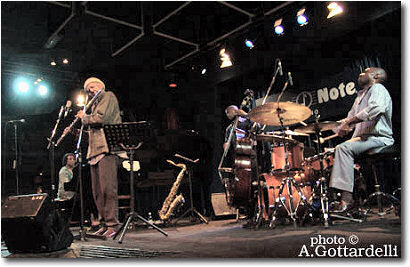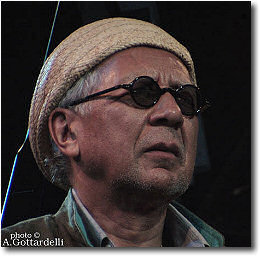
This evening at Blue Note we
shall have the opportunity to listen to the mellow and poetic voice of
Charles Lloyd's tenor sax, accompanied by his excellent rhythm section
and by an extremely gifted and talented pianist: Geri Allen. He has
already been on tour with this unit, playing a series of wonderful concerts.
Charles Lloyd, the myhtical tenor saxophonist now sixty-five, is a legend
of the American West Coast, and was trained in the school of Coltrane.
Part Cherokee and part Irish, his carreer starts in Los Angeles, at times
siding, and at times replacing Ornette
Coleman and Eric Dolphy. In the mid-sixties he's at the
climax of his success, reaching the incredible apex of one milion copies of his
album "Forest Flower" which had been recorded live at the Monterey Jazz Festival
in 1966. He plays at the legendary rock palace
Fillmore West in San Francisco where rock stars such as Janis Joplin, Jimi
Hendrix, Grateful Deed and other rock superstars were permanently on stage. No
jazzman had ever reached such peaks before him.

By the mid-sixties he has gained himself a very strong reputation with
his "Flower Power" quartet featuring very talented and promising artists:
a very young Jack De Johnette at the drums and an equally young Keith
Jarrett at the keyboards and Cecil McBee (later succeeded by
Ron Mcclure). With this group he won all the best stages troughout the
whole World, and toured in the U.S.S.R.
By the end of the '60s and the
beginning of the '70s Charles
Lloyd fades out of music, and he studies oriental religions, becoming a
teacher of trascendental meditation. He leaves the stage for about a decade. In
the early ‘80s we see him back on stage with Michael Petrucciani, unforgettable
pianist and musician, also discovered by the great tenor saxophonist.
"Lift Every Voice" is a double album released in 2001, featuring Geri Allen at the keyboards,
John Abercrombie at the guitar, Marc Johnson and Larry
Grenadier that swich at the double-bass and Billy Hart at the drums.
It is a collection of spirituals, folk songs, hymns, standards, love songs and
protest songs. It is Charles Lloyd's reply to the tragedy of September
11th 2001. On that evening he was
supposed to be playing at Blue Note in
New York. After having considered cancelling his dates, he played a week
later.
In 2004 ECM issues a Charles
Lloyd double CD of intimate duos with Billy Higgins, "
", recorded at Charles Lloyd's home
before Higgins' passing. Both play a wide variety of instruments.

He is now going to play for the Blue Note
audience in Milano, accompanied by a rhythm section featuring only black
musicians. At the piano (Charles Lloyd has constantly proved, throughout
his whole carreer, and through his choices, how meaningful and important the
piano accompanyment is for him) we find a beautifully gifted Geri Allen,
 one of the best pianists that can be
found in the contemporary musical setting: in 1988 she signs up with Wayne Shorter; in
1990 Ron Carter and Tony Williams
define her as an extraordinary pianist, and in 1995 she receives the "Lady of Soul Award"
for Best Jazz Album as part of the first annual "Soul Train Lady of Soul
Awards". Detroit-born Geri Allen has collaborated with avant-garde
musicians such as Steve Coleman and M-Base Collective. She
recorded with Anthony Cox, Andrew Cyrille, Charlie Haden,
Paul Motian, Ron Carter and Mal Waldron.
one of the best pianists that can be
found in the contemporary musical setting: in 1988 she signs up with Wayne Shorter; in
1990 Ron Carter and Tony Williams
define her as an extraordinary pianist, and in 1995 she receives the "Lady of Soul Award"
for Best Jazz Album as part of the first annual "Soul Train Lady of Soul
Awards". Detroit-born Geri Allen has collaborated with avant-garde
musicians such as Steve Coleman and M-Base Collective. She
recorded with Anthony Cox, Andrew Cyrille, Charlie Haden,
Paul Motian, Ron Carter and Mal Waldron.
This unit features Reuben Rogers (double-bass) and Eric
Hartland (drums), two extremely talented young musicians.
 This set we are
experiencing is truly fascinating: accompanied by a knowing rhythmical section
and by a pianist such as Geri Allen, Charles Lloyd has totally
siezed the audience's attention with the aetherical and soft-toned voice of his
tenor sax, that carries us, and makes us fly to ethnical and oriental-flavoured
atmospheres. We also have the chance to experiment the poetical and spiritual
voice of his flute…. A wonderful concert, contemporary music endowed with a
highly evocative power. More than once, during the concert, I found myself
observing, with the eyes of my imagination, sceneries that Charles Lloyd
and his group had painted with their notes and rhythms right before my
eyes….
This set we are
experiencing is truly fascinating: accompanied by a knowing rhythmical section
and by a pianist such as Geri Allen, Charles Lloyd has totally
siezed the audience's attention with the aetherical and soft-toned voice of his
tenor sax, that carries us, and makes us fly to ethnical and oriental-flavoured
atmospheres. We also have the chance to experiment the poetical and spiritual
voice of his flute…. A wonderful concert, contemporary music endowed with a
highly evocative power. More than once, during the concert, I found myself
observing, with the eyes of my imagination, sceneries that Charles Lloyd
and his group had painted with their notes and rhythms right before my
eyes….
That's why I tend to spontaneously compare this music to the
masterpieces of the great impressionists: with the phrasings of his sax,
Charles Lloyd and his excellent musicians paint bright strokes on their
canvas, creating areas of light and shade exactly as a Master would do on his
masterpiece.
At the end of the first set we congratulate with Charles Lloyd
and with his excellent musicians on his concert, thanking him for the music, the
emotions and the feelings they offered us, and we meet an extremely affable and
corteous artist, open to human contact.

